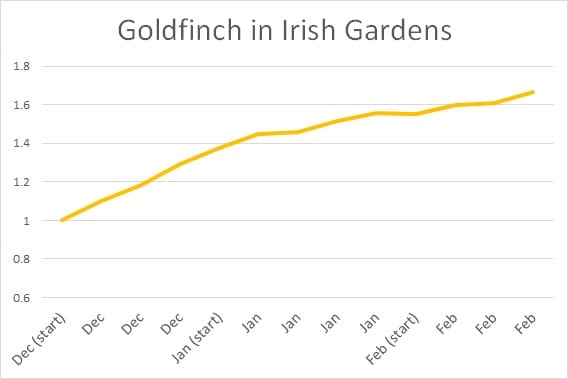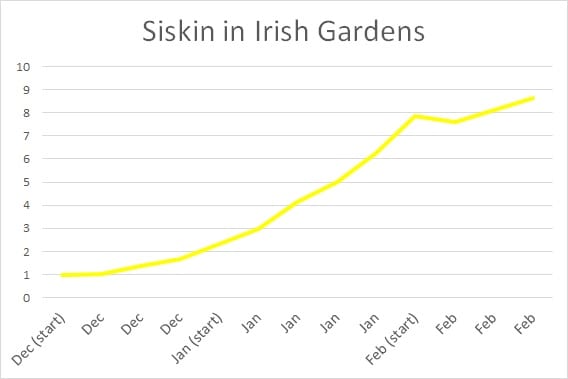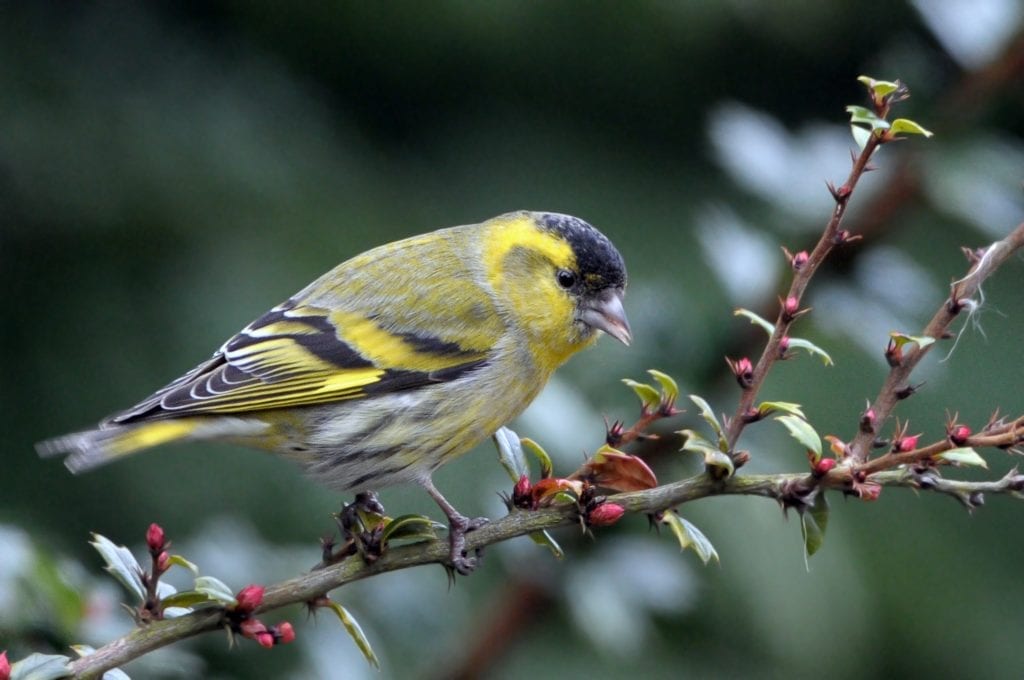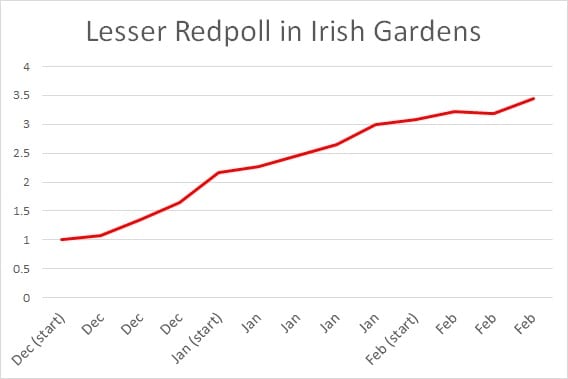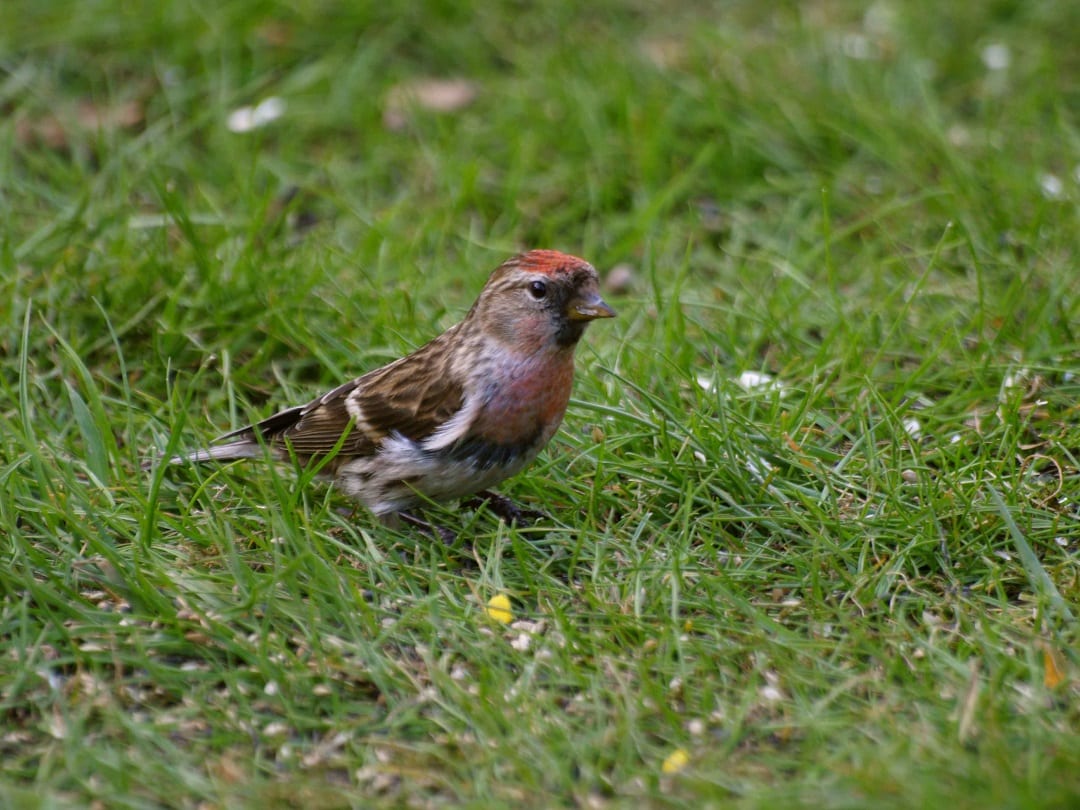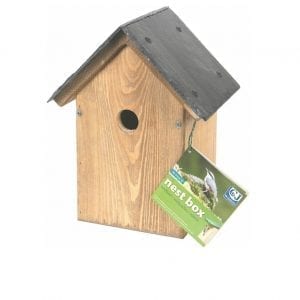We’re now into the home stretch of this winters Irish Garden Bird Survey, and this time of year tends to bring a lot of changes to the bird communities in Irish gardens!
When the Irish Garden Bird Survey starts each December, there’s often a good bit of food available to most species in the wider countryside – seeds on mature broadleaf trees, berries and fruits in hedgerows, and depending on how cold the weather has been there might even be a good supply of invertebrates around too. Couple that with the fact that our migrant thrush and finch species are still arriving into Ireland in December, and it means that the diversity and number of birds in your garden can be quite limited up until around Christmas.
After that though, things start to change! That food in the wider countryside gets depleted, and birds are becoming more desperate for other sources of food. Day length is at its shortest at this time of year too, meaning less time for birds to find food and longer, colder nights for our tiny feathered friends to try and survive through. This period of the year has been shown to be hugely important to the survival and population numbers of farmland birds and is known as the ‘hungry gap’. So its no surprise that this is the time of year when numbers of your favourite garden birds start to increase!
See below for some information on species who will be making their presence felt in gardens across Ireland in the coming weeks, as shown over the 30 years of the Irish Garden Bird Survey to date! We wouldn’t have this information if it wasn’t for people like you taking part in the survey each year – so make sure to keep going for the final weeks of the survey so that we can build up an accurate picture of how Irish garden birds fared in winter 2019/20!
Goldfinch
Goldfinch were only seen in around a third of Irish gardens 20 years ago, but their numbers have continued to increase since that time and now they’re regularly seen in 80% of gardens each winter. They’re seen in most gardens right throughout the Irish Garden Bird Survey, but the graph here shows their numbers in gardens increases significantly as the winter goes on! We often get people telling us that between sunflower hearts and nyjer seed, their local Goldfinches are eating them out of house and home – but who could be angry with a bird as beautiful and ‘charming’ as that?!
Read more about Goldfinches here.
Siskin
Siskins are a small species of finch, with a small pointed bill adapted for feeding on very fine seeds, not unlike the Goldfinch. Like the Goldfinch too, they are a species that’s very fond of nyjer seed, though they will readily take to peanut and sunflower seed feeders too. They are seen in barely any gardens in December, increasing a bit in January, but by the start of February much of the natural food they rely upon (seeds on trees like Alder and Sitka Spruce) are gone and your garden feeders provide the ideal substitute! Despite their slow start to the winter, they can occur in over 40% of gardens by the end of February each winter. Many of these birds will have come here for the winter from Scotland and Scandinavia, so they desperately need to refuel before migrating back in March and April!
Lesser Redpoll
Another small finch, closely related to the Siskin, again with a fine bill and a similar excuse for being absent from gardens until after christmas, with numbers building into February and beyond! The red isn’t always obvious on these birds, particularly on the females, and so some people can confuse them with other finch species including Twite (never come to gardens) or Linnets (much bigger!). If you have Goldfinches in your garden, chances are you have a good set up for attracting Redpolls too and they often come to nyjer, sunflower hearts and peanuts too!
Read more about Lesser Redpolls here.
Blackcap
The Blackcap is a warbler species, and like the other warblers we have in Ireland, those that breed here leave and migrate south for the winter. While our Irish-breeding Blackcaps are in Iberia and northern Africa during our winter months, Blackcaps from central Europe (same species, but a different population!) come to Ireland for the winter! This migratory route is thought to have developed in part due to the availability of food in Irish gardens, with a warming climate also likely to be playing a part. Numbers in gardens are low in December when there are still berries and fruits in the wider countryside to feed on, but by the end of February there’ll be around three times as many Blackcaps in Irish gardens as there was when the Irish Garden Bird Survey started in December. They’ll eat peanuts and fatballs in your garden, but also enjoy apples when cut in half and placed in a tree or on a bird table! Keep an eye out for brown-capped females too!
Read more about Blackcaps here.
And the rest…
The above are species that show a consistently strong trend, year after year, of increasing numbers from early December when the Irish Garden Bird Survey starts, to the end of February when the survey finishes. They’re not the only species that show this trend though. Great Spotted Woodpeckers show a similar trend, though the effect isn’t as strong as they still only appear in a small number of gardens in Ireland so far. For other species including Blackbird, Song Thrush, Redwing and Fieldfare, their occurrence in gardens is very weather dependent an you might see a big influx if we get snow or heavy frost in the coming weeks. The Pheasant hunting season is over for another year now too, so this may mean a wandering Pheasant might turn in your garden yet – taking advantage of any seed spilled beneath your feeders. If we get a mild February, you might start to see some territorial behaviour and birds leaving your garden as they start thinking about finding somewhere to nest.
Don’t forget that now is the perfect time to put up a nestbox in your garden! We’ve got a wide selection of nestboxes available in our shop, and by buying from us you’re also helping support or vital conservation work!
See our selection of nestboxes here.
The Irish Garden Bird Survey is BirdWatch Ireland’s longest-running survey and is vital in tracking the fortunes of Ireland’s garden bird species through the harsh winter months.
For more details about the survey click here.
The survey is sponsored by the Ballymaloe Group.


